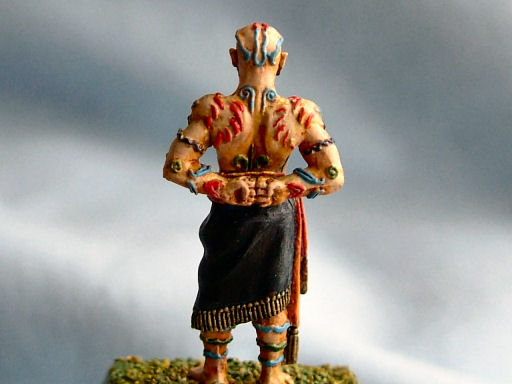
| Monsters | - | Dragon 106 | - | Dragon |
The hearthfire flickered in the tavern
known as The Leaning Post. The evening
was old, and the few tipplers left in the
taproom were crouched close around the
fire. Tongues were wagging with tales of
fell
keeps and grim adventures, and monsters
most strange. Old Urvan, a grizzled warrior
of scars and reputation most grim, rubbed
his bald pate and disagreed with a younger
man.
?Nay,? he rumbled, wagging a cold grey
eye, ?men die like cattle, for all their
armor;
I?ve fought a dozen, on horseback,
and slain them all, and me a lone man with
but my fists. But the woman-monster, the
medusa, the maiden who turns ye to stone,
is far the worse.?
From his dark corner, Elminster coughed.
?Oh? Think ye so?? he said casually. Everyone
fell silent at the sage?s words. He
spoke seldom, but his tales were not soon
forgotten. Old Urvan fixed the sage with
a
colder grey eye and emitted a grunt that
urged Elminster to speak.
?The medusa
is a fearsome thing, true,?
Elminster said slowly, looking around the
firelit circle of faces. ?But as bad or
worse is
the male, the stealer-through-stone, the
maedar. Medusae, ye see, have mates. An?
they?re by far the deadlier sex. . . .?
Elminster then unburdened himself of the
tale of Ilguld the illusionist and the
Walking
Stone of Yarech. It is a long tale, full
of
mimes and bawdy jests and local jokes,
and
unless one is the raconteur Elminster is,
?tis
better to paraphrase, thus:
Ilguld was an adventurer, the youngest
and least powerful of a proud and reckless
band who rode out of Waterdeep often,
combing the caverns of the wild North.
On
one jaunt, the group met a medusa, whose
gaze turned two brawny warriors to unmoving
stone. The survivors withdrew hastily
and thought of a plan. Ilguld had with
him
a small mirror, and this he tied across
his
eyes so that, peering down, he could see
only the ground before his toes. He covered
himself in his storm cloak, the cowl thrown
forward to conceal his face.
Thus prepared, Ilguld advanced into the
monster?s lair, shuffling like an old man
and
leaning on a staff. The medusa rushed him
to bite and slay. As he tried to fend her
off
with his staff, she tore open his cowl
? and,
gazing into the mirror, turned herself
to
stone while she still clutched him.1
Ilguld tugged himself free of the stony
grasp, ran from the lair, and called his
comrades out of hiding. They rushed forward
heedlessly to seek the medusa?s treasure,
waving aside Ilguld?s stammered
warnings, and were soon deep within the
maze of small caverns that made up the
medusa?s lair. Ilguld followed more cautiously,
and was scared badly when he saw
his comrades at the other end of a long
cavern ? coming back toward him as fast
as they could run with their bags of coins
and coffers of gems. The illusionist noticed
immediately that two of the band were
missing. As he watched, a part of the wall
seemed to move, reaching out to fell the
rearmost adventurer. At that, Ilguld cast
a
spell of invisibility on himself and fled
until
he was just inside the entrance to the
lair.
Seconds later he again heard the weaponclanking
and curses of his comrades. They
had dropped their treasure and were running
hard. The men, now without two more
of their number, burst past him and out
of
the cave. Ilguld remained frozen as he
beheld what had chased them out ? a
muscular, bald-headed man clad only in
breeches, who came behind the group at
a
fast trot2.
Ilguld dared to leave the cave entrance
after this strange man passed, taking care
not to stumble or make undue noise. He
turned in the direction his friends had
gone,
and just ahead he saw them ? statues, all,
frozen forever in the midst of their flight.
Beyond the statues stood the medusa, stone
no more, her arms raised in triumph.3
As he watched the bald man approach the
medusa, Ilguld realized that she must have
somehow been restored to life and had left
the lair by another route so as to lie
in wait
for the intruders to exit. The medusa and
the man embraced, and she spoke to him
in
loving tones.4 Ilguld was amazed again
by
what happened next. He saw the man shatter
the stone form of his fellow mage and
then touch some of the fragments, which
turned from stone rubble to bloody flesh.
The bald man and his mate, the medusa,
sat down to eat as Ilguld tore his gaze
away
from the scene and stole away as softly
as he
could.
?A likely story,? Urvan scoffed. ?One
man, weaponless, defeating an entire
band??
?Why, Urvan,? Elminster replied mildly,
lifting his tankard, ?I hear from your
own
lips that such a feat ? defeating a dozen
armed men, and their horses too ? is easy,
if one has but the use of both fists. Is
it then
not so??
?Phauugh,? Urvan replied eloquently.
-
1. The gaze of a medusa can turn itself
or
any other medusa to stone. Such petrification
is permanent unless reversed by spell or
special ability (see note 3 below).
2. Maedar are the male counterparts of
the medusae. (Singular and plural forms
of
?maedar? are the same; the name can be
used to refer to both genders collectively,
or
to the male alone. The latter usage is
employed
in this text.) The maedar are far
rarer and more reclusive than their mates,
and are seldom seen. Many men do not
even know, or believe, that they exist.
They
dwell in the depths of caverns, guarding
the
pair?s hoard of treasure (and food) while
their mates hunt.
Maedar appear as bald-headed (in fact,
completely hairless) muscular human males.
In all statistics they are identical to
medusae,
except that they have two attacks per
round, doing 2-8 points of damage with
each blow of their mighty fists. Maedar
cannot petrify other creatures and are
themselves
immune to petrification and paralyzation
(including related magics such as slow
and hold spells) from any source whatsoever,
although they can be confined by
webs, forcecages, and the like.

3. Maedar have the ability to turn stone
to flesh by touch, once every three turns.
Thus, one can free a medusa who has gazetrapped
herself to stone ? or, by smashing
petrified prey to rubble and then turning
it
to stone, gain an easy meal for himself
and
his mate from a creature petrified earlier
by
the medusa. Like medusae, maedar can see
into the Astral
Plane and the Ethereal
Plane, and they can use their stone to
flesh
ability into those planes as well.
Maedar possess the ability to pass
through stone as xorn and xaren do, at
normal movement rate. A maedar requires
one round of concentration to adjust his
molecular structure before entering rock
and after leaving it again; no other activity
may be undertaken during this round. If
struck by a phase door spell while passing
through stone, a maedar is killed. If a
mated maedar and medusa are confronted
by a stronger creature in their lair, the
male
will abandon the female to her fate without
hesitation, escaping through the rock walls
of the cavern. However, a maedar will
never neglect to unpetrify a medusa when
it
is safe to do so.
The treasure of a medusa and maedar is
usually concealed (behind loose stones,
in
crevices, etc.) in addition to being guarded
by the maedar. The males monitor the
treasure continuously and frequently move
it from place to place within the lair,
particularly
to discourage thievery by other creatures
able to pass through stone. Males and
females alike will flee from strong attackers,
abandoning whatever treasure they cannot
carry, rather than defend a hoard to the
death. The treasure hoard of a medusa and
maedar will almost always contain a selection
of feminine garb that doubles as the
medusa?s wardrobe.
4. All maedar and medusae speak and
understand the language of lawful evil,
the
common tongue, and any other languages
spoken often by creatures in the vicinity.
Details of the courtship of a mated pair
are
unknown, but they do pair for life (one
choosing another partner only if a mate
is
slain), and live and hunt together at all
times. The female produces 1-3 live young
every 10 years or so. Young have the same
abilities as their parents, but no physical
attacks and only 1-2 HD. (A young female
can petrify, and a young male can pass
through stone and turn stone to flesh;
however,
the asplike, poisonous ?hair? growth
of a medusa develops only in maturity,
and
young maedar lack the strength for damaging
blows.) Offspring gradually gain hit dice
as they approach maturity and adulthood,
a
process that typically takes four or five
years. When they reach maturity and gain
the ability to physically attack, the young
are roughly encouraged to strike out on
their own; no more than one adult medusa
and one adult maedar will ever be found
in
the same lair. If a medusa is slain but
her
mate survives, the male will search tirelessly
for the killer(s) to take revenge, sometimes
pursuing such quarry for years. A maedar
can track as a ranger does, but this does
not
include the ability to follow the trail
of a
creature that has passed through stone.
All
maedar and medusae are immune to the
poison of (their own and other) medusa
hair
growths.
Medusae and maedar respect, but do not
worship, Skoraeus
the Living Rock (see
Legends & Lore, Nonhuman Deities),
and
have a like attitude toward lawful evil
deities
and creatures. They will cooperate with
lawful evil creatures such as orcs, kobolds,
or even devils, for reward or security
or
(rarely) under duress. If forced to aid
or
serve another, they will always seek revenge.
Meader and medusae cannot be
trusted by other creature except of their
ilk.
Occasionally they will bargain with, or
purchase information or services with,
their
treasure.
THE FORUM
In the article on the medusa
and the maedar in
issue #106, I detected an ambiguity which
I think
needs some clarification. It described
the maedar
converting stone to flesh from adventurers
that
the medusa had petrified, and the medusa
and
maedar using this as a source of food.
Yet the
article also stated that the medusa would
leave the
lair to hunt. If the maedar had the ability
to
convert pure stone to true flesh, what
need would
there be for a medusa to hunt, as an ample
food
supply could be obtained directly from
rocks?
A rational explanation in my opinion would
be
that the petrification power of the medusa
does
not turn flesh into true stone, but rather
into a
substance as hard as stone ? possibly by
a process
of solidification of the fluids normally
present
in living organic creatures. For example,
water in
the liquid form is very soft and flexible,
whereas
water in the solid form (ice) is very rigid
and
hard. Also, all living organic creatures
have
certain species-specific essential nutrient
requirements
(e.g., vitamins and minerals). Therefore,
although the maedar could convert true
stone into
a substance as soft and flexible as flesh,
it would
not be true flesh because it would not
have the
chemical composition of true flesh. Only
“stone”
which had originally been true flesh would
contain
those chemical nutrients which the medusa
and maedar would need for adequate nutrition.
J. M. Talent
Denton, Tex.
(Dragon
#108)